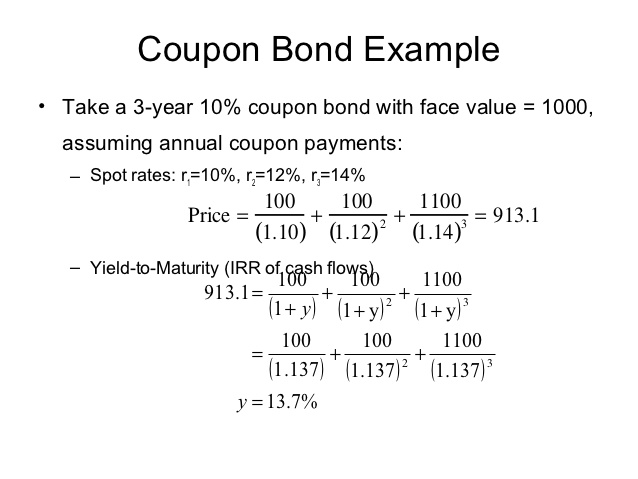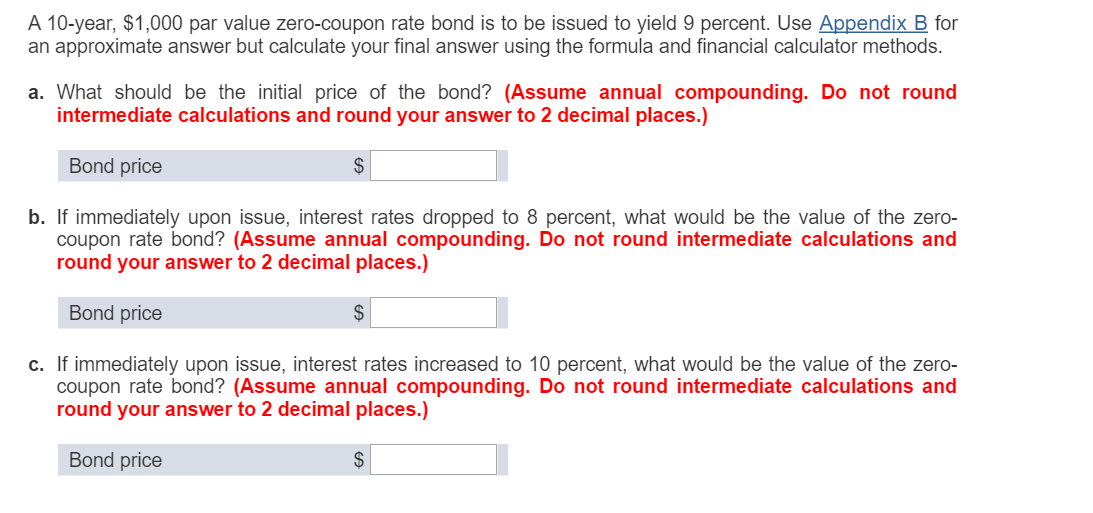Par value coupon bond
Contents:
Bond Pricing Example
The fraction of the coupon payment that the bond seller earns for holding the bond between payments is called accrued interest. Since many bonds on the secondary market trade in between coupon payment dates, the bond seller has to be compensated for the portion of the coupon payment it earned for holding the bond since the last payment. This basically gives both the seller and buyer a pro-rated coupon payment for that period.
Related Articles. Pull To Par Pull to par is the movement of a bond's price toward its face value as it approaches its maturity date. Such premium amortization is not available for tax-free bonds purchased at a price above par. See Why do interest rates have an inverse relationship with bond prices? Find a degree that fits your goals.
The next coupon payment is expected on July 1. From our previous example, we know there are 90 days remaining. Now we can calculate the accrued interest using the following formula:. Note that bonds are priced as clean or dirty, depending on whether accrued interest is included. Most bonds are quoted at clean prices and transacted at dirty prices, which include the accrued interest. Advanced Bond Concepts: Introduction Advanced Bond Concepts: Bond Pricing Advanced Bond Concepts: Duration Advanced Bond Concepts: Convexity Advanced Bond Concepts: We can combine the bond price formula and the annuity model to arrive at the following formula, which requires us to also include the present value of the par value reached at maturity: Determine the number of coupon payments.
Par value is important for a bond or fixed-income instrument because it determines its maturity value as well as the dollar value of coupon. A bond's coupon rate is equal to its yield to maturity if its purchase price is equal to its par value. The par value of a bond is its face value, or the.
Determine the semi-annual yield. Enter the amounts into the formula: Determine the number of periods. The required yield of zero-coupon bonds is usually based on a semi-annual coupon payment.
Pricing Zero-Coupon Bonds
As such, the number of periods will be doubled to 10 periods 5 X 2. Determine the yield.
- Coupon Rate.
- ola kolkata free coupon code.
- gradys restaurant coupons.
- e coupons for walmart;
- Face Value.
- dunkin donuts box of joe coupon.
Pricing Bonds Between Payment Periods So far, our pricing calculations have assumed that we are buying bonds where the next coupon payment is one payment period away. Each bond market has its own convention: The next coupon payment would be in 61 days: Determine Accrued Interest The fraction of the coupon payment that the bond seller earns for holding the bond between payments is called accrued interest. Now we can calculate the accrued interest using the following formula: Related Articles. To determine the value of a bond today — for a fixed principal par value to be repaid in the future — we can use an Excel spreadsheet.
A bond is not likely to trade at par when interest rates are above or below its coupon rate.
When is a bond's coupon rate and yield to maturity the same?
When a company issues a new security , if it receives the face value of the security, then the issuance is said to be issued at par. If the issuer receives less than the face value for the security, it is issued at a discount; if the issuer receives more than the face value for the security, it is issued at a premium.
- Coupon (bond) - Wikipedia.
- Bond Pricing - Formula, How to Calculate a Bond's Price.
- Advanced Bond Concepts: Bond Pricing?
The coupon rate for bonds or dividend rate for preferred stocks has a material effect on whether new issues of such securities are issued at par, at a discount or at a premium. The investors receive the coupon but have to pay up for it due to the lower prevailing yields.
- quality liquor store online coupon?
- When is a bond's coupon rate and yield to maturity the same??
- Coupon Rate - Learn How Coupon Rate Affects Bond Pricing.
- Consider a coupon bond that has a $1,000 par value and a coupon rate of 10%. The bond is....
- nara resort deals.
Par value for common stock is not often mentioned because it is an arbitrary value mostly for legal purposes. Whether a common stock is issued at par or not does not affect its yield for investors like bonds and preferred stock, nor is it a reflection of prevailing yields. Your Money.
Personal Finance. Financial Advice.

Popular Courses. Login Advisor Login Newsletters.
Bond Pricing
What is At Par At par, commonly used with bonds but is also used with preferred stock or other debt obligations, indicates that the security is trading at its face value or par value. Compare Popular Online Brokers. The offers that appear in this table are from partnerships from which Investopedia receives compensation.
